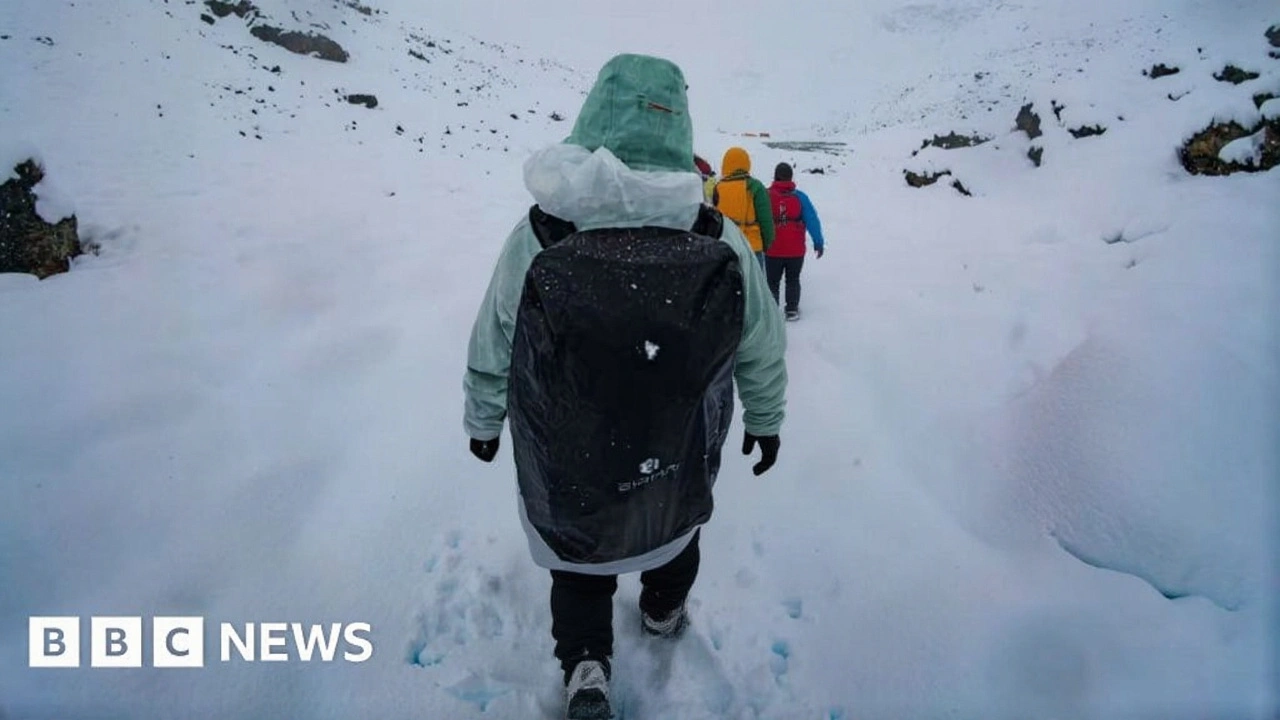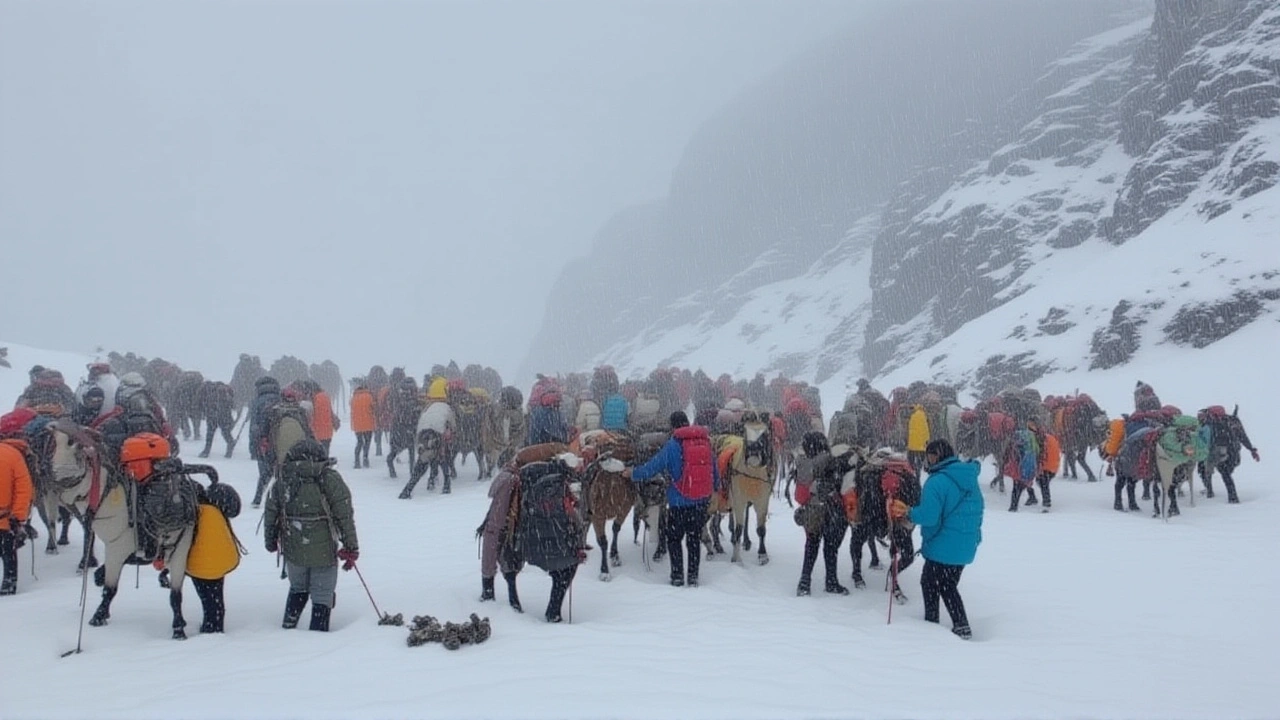
When Dong Shuchang, a seasoned nature photographer, set out for the Tibetan side of Mount Everest during China’s Golden Week in early October 2025, he could not have imagined being caught in a historic snowstorm that would strand more than 500 trekkers above 4,000 m. Chinese authorities, represented by the Tibet Tourism Bureau, mobilised hundreds of rescuers, local yak herders and even drones to pull people to safety, while the world watched the unfolding crisis.
Background: Why October Is a Magnet for Everest Trekkers
Everest’s northern slopes have long been a favourite for mid‑season hikers. The window from late September to early November is traditionally seen as the "golden" period: monsoon rains retreat, skies clear and snow cover is manageable. In recent years, the Chinese government has promoted the Karma Valley trek as a low‑cost alternative to the classic Base Camp trek, selling over 20,000 tickets annually. The 2025 Golden Week holiday, a seven‑day break that sees domestic travel surge, was expected to bring a fresh wave of visitors to the region.
What makes this year different is a combination of climate anomalies and operational pressure. The Bay of Bengal produced an unusually warm, moist low‑pressure system that drifted northward. When that air mass slammed into the frigid Himalayan plateau around 4,000 m, it ignited a convective snowstorm – a rare meteorological event for early October.
Storm Details: The Blizzard That Turned Trekking into Survival
According to the Reuters report dated October 4, snowfall began Friday evening and intensified through the weekend. Snow drifts exceeded one metre in depth in some valleys, and gale‑force winds ripped tents from their anchors.
- Peak snowfall: >1 m in the Karma Valley area.
- Wind speeds: reported up to 80 km/h.
- Visibility: dropped to less than 50 m after midnight on Saturday.
Trekkers described clearing snow every 90 minutes just to keep their shelters from being buried. "The lightning and thunderstorms would not stop. The snowfall was so heavy I could hardly sleep," Dong recalled, his voice shaking as he recounted the night at 4,600 m.
The storm was later classified as an Everest BlizzardMount Everest, Tibet. It lasted roughly 48 hours, wiping out the usual safety margin that guides rely on.
Rescue Operations: A Race Against Time at 5,000 Metres
By Sunday morning, local officials estimated nearly 1,000 people were trapped on the Tibetan side. The Tibet Tourism Bureau set up an emergency operations centre in Qudang, a village perched at 4,200 m, as the hub for evacuation.
Rescue teams deployed a mixed fleet: seasoned yak herders clearing paths on foot, horse‑backed guides ferrying supplies, and unmanned aerial vehicles scanning for stranded groups. Satellite phones and WeChat groups kept contact with about 200 hikers still lodged above 4,600 m.
By Wednesday, 350 trekkers had made it down to Qudang, where temporary shelters, warm food and medical tents were set up. One hiker, a 32‑year‑old from Chengdu, succumbed to hypothermia on the 4,900‑m ridge, confirming the first fatality of the incident.
"We were forced to improvise,” said Li Wei, a rescue commander with the Tibet Tourism Bureau. “The storm knocked out the usual rope‑fixed routes, so we had to break new trails with hand tools while the wind was still howling.”
Safety Gaps and Policy Questions
The episode has reignited debate over high‑altitude tourism regulation. Critics argue that ticket sales were pushed without adequate real‑time weather monitoring. The Bureau, however, points out that the storm’s speed caught even satellite‑based forecasts off‑guard.
Independent mountain‑guide association (MGA) spokesperson Chen Yong noted, "We need mandatory weather briefings, mandatory high‑altitude medical kits, and stricter altitude limits for first‑time trekkers." The Chinese Ministry of Culture and Tourism announced on Thursday that ticket sales to the Everest Scenic Area would be suspended until a full safety audit is completed.

Climate Lens: Is This an Isolated Event?
Climatologists warn that Himalayan weather is becoming more volatile. Dr. Aisha Rahman of the Beijing Climate Institute highlighted that warming in the Bay of Bengal has increased the frequency of moisture‑laden lows that can surge northward.
"What we saw is a classic ‘rain‑on‑snow’ event that historically occurs in spring, not autumn," she explained. "If the trend continues, we could see similar blizzards during the peak tourism season, which would be catastrophic for the local economy and safety infrastructure."
Looking Ahead: What Travelers Can Expect
For now, the focus is on getting the remaining 200 hikers out. Rescue crews are preparing to use high‑altitude helicopters, weather permitting, to shave days off the evacuation timeline.
Travel agencies are re‑evaluating itineraries, offering lower‑altitude alternatives and pushing for better insurance coverage. Meanwhile, the Tibetan government is investing in renewable‑energy powered communication towers to ensure that even the most remote camps stay linked during future storms.
Key Facts
- Event: Everest Blizzard, Oct 3‑5 2025
- Location: Northern slopes of Mount Everest, Tibet
- People affected: ~1,000 trekkers; 350 rescued, ~200 still stranded
- Fatalities: 1 confirmed death (hypothermia)
- Rescue assets: Yak herders, horses, drones, satellite phones, planned helicopter lifts
Frequently Asked Questions
How does the blizzard affect future high‑altitude tourism on Everest?
Operators are likely to tighten permit rules, enforce mandatory weather briefings and require higher‑altitude medical kits. The recent suspension of tickets signals a shift toward stricter safety protocols for the Karma Valley trek and similar routes.
What caused the unprecedented snowfall on Everest?
Meteorologists traced the storm to a warm, moist low‑pressure system over the Bay of Bengal that pushed humid air northward. When this air collided with the cold Himalayan layer at around 4,000 m, it generated a convective snowstorm—an event usually reserved for spring, not October.
Who coordinated the rescue effort?
The Tibet Tourism Bureau led the operation, working with local yak herders, provincial rescue teams, and the Chinese Ministry of Emergency Management. International outlets like Reuters provided on‑ground updates.
What safety measures were lacking during the storm?
Many trekkers lacked real‑time weather alerts and adequate high‑altitude gear. Guides reported that evacuation routes were not marked for extreme snow, and communication devices failed as the storm knocked out cellular towers.
Will climate change increase the frequency of such events?
Experts like Dr. Aisha Rahman warn that warming in the Bay of Bengal and the Himalayas is making weather patterns more erratic. This could lead to more off‑season blizzards, posing ongoing risks for the region’s tourism industry.
Comments (13)
-
Fabian Rademacher October 6, 2025
They let a profit‑driven machine push thousands up a frozen wall, ignoring the fact that the climate’s getting crazier because of hidden geo‑engineers pulling strings behind the scenes.
-
Terrell Mack October 6, 2025
Hey, I get the worry, but kudos to the rescue teams and yak herders who stepped up when the storm hit – they’re the real heroes pulling folks to safety.
-
Dawn Waller October 7, 2025
Oh, sooo, you think the blizzard is just a "big ol’ Hollywood set‑up", huh??!! Like, maybe Mother Nature took a coffee break and left the storm on autopilot?? Reality check: climate change is real, not some secret "control panel" in a basement?? But sure, keep sipping that conspiracy tea.
-
Grace Melville October 7, 2025
Quick tip: always pack a high‑altitude medical kit and a reliable satellite phone – they can be lifesavers 😊
-
Ashlynn Barbery October 7, 2025
In light of the recent Everest blizzard, it is incumbent upon regulatory bodies to reassess the risk assessment protocols governing high‑altitude tourism. The unprecedented snowfall, driven by anomalous moisture influx from the Bay of Bengal, underscores the volatility of contemporary weather patterns. Consequently, mandatory pre‑expedition briefings must incorporate real‑time meteorological data and contingency planning. Moreover, permits should be contingent upon demonstrable acclimatization and prior experience at comparable elevations. The deployment of drones and satellite communication devices proved invaluable; however, reliance on these technologies alone is insufficient without robust ground support. It is advisable to institutionalize the presence of trained high‑altitude medical personnel on each trekking party. Furthermore, the establishment of clearly marked evacuation corridors, reinforced with wind‑resistant anchoring systems, would mitigate the hazards posed by sudden gusts. The tragic loss of life, albeit limited, illustrates the dire consequences of inadequate preparedness. Investment in renewable‑energy powered communication towers, as mentioned, represents a forward‑looking approach to maintaining connectivity. In addition, the suspension of ticket sales should be treated as a temporary measure pending a comprehensive safety audit. Stakeholders, including travel agencies and local guides, must collaborate to develop standardized safety kits. Finally, ongoing climatological research should be funded to better predict future extreme weather events, thereby safeguarding both tourists and the local economy.
-
Jared Mulconry October 7, 2025
It’s a stark reminder that even seasoned trekkers need to respect nature’s limits and have solid backup plans.
-
Daisy Pimentel October 7, 2025
We cannot overlook the moral responsibility of agencies that sell adventure packages without ensuring the well‑being of participants; profit should never eclipse safety.
-
Ellen Ross October 7, 2025
Frankly, the whole enterprise reeks of elitist tourism that pretends to be accessible while ignoring the brutal truth of Himalayan weather-an oversight that is both reckless and intellectually lazy.
-
Virginia Balseiro October 7, 2025
Stay safe, everyone!
-
Brandon Rosso October 7, 2025
It is heartening to see the coordinated effort of rescue teams, and I remain confident that the remaining trekkers will be brought down promptly. The implementation of high‑altitude helicopters, weather permitting, should expedite the process. Let us commend the dedication of yak herders and local guides who risked their own safety. This incident also serves as a catalyst for necessary policy reforms. Together, we can ensure future expeditions are both adventurous and secure.
-
Tracee Dunblazier October 7, 2025
While the article highlights the gaps, it could have delved deeper into the systemic complacency that allowed such a scenario. The lack of mandatory weather briefings is a glaring oversight. A more rigorous audit framework would benefit both locals and tourists alike.
-
Edward Garza October 7, 2025
Another example of sensationalism without substantive analysis. The piece fails to propose actionable solutions.
-
Allen Rodi October 7, 2025
Great discussion, folks. Let’s keep sharing best practices and support the ongoing safety initiatives for Everest trekkers.
